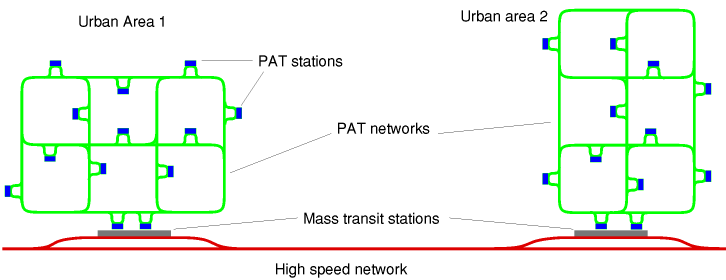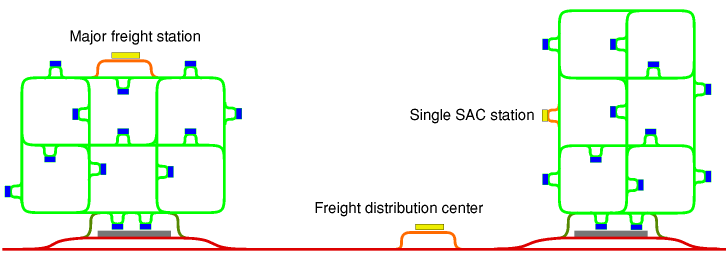Finding space in cities for new transport infrastructure is expected to be difficult. Vehicles and their guideway sweep a volume with a constant cross-section along a continuous path. Having established a path, at great cost and against all sorts of opposition, it makes sense to make as much use of it as possible using it to carry variety of types of traffic.
It is also self-evident that these paths will be easier to find if the cross-section is kept to a minimum and the structures are light-weight. On the following pages we discuss how combining different types of vehicle, the appearance and traffic volumes will determine the optimum guideway geometry . We also discuss ways in which the life-cost of the fixed infrastructure might be reduced and the time-scale for the introduction of new technology .
Here is an example of how different types of traffic would be combined:

This figure shows two PAT networks, shown in green, associated with part of a high speed mass-transit system, shown in red. PAT stations are positioned close to the mass-transit stations so that PAT network can act as a feeder for the mass-transit line.

We propose that the guideways are designed so that at least some vehicles can use both the PAT and the mass-transit line.
At peak times the passenger volume would be sufficient to warrant a frequent service on the high-speed guideway. However, in off-peak times, PAT vehicles could be use the high-speed guideway to take passengers from one area of PAT guideway to another.

We propose further that the combined network can carry freight as well as passengers. This will be greatly facilitated by the introduction of the Small Smart Automated Container
The PAT network, shown in green, has vehicles moving at upto 40 m/s providing a taxi-like service with a capacity of up to 2500 passengers per hour. The vehicles on the mass-transit network, shown in red, would typically run at 120 m/s and could have a capacity of 30,000 passengers per hour, providing a higher speed and capacity metro-style of service with articulated vehicles with many seats.
Clearly not all vehicles can go on all the tracks. Multi-section vehicles would not use PAT stations and could not use vertical movements. Passenger vehicles would not have any business in freight stations and freight vehicles would not need to visit passenger stations (unless they were carrying a few off-peak passengers as well as freight).
The idea is to run the mass-transit vehicles on demand. Passengers allocated to vehicles and vehicles allocated to routes dynamically. Journeys would be optimised for the passengers, minimising the number of changes and no unnecessary intermediate stops while maintaining an efficient use of seating capacity and ensuring that vehicles are in the best locations to meet demand.
Typical journeys might include sections where there is a choice between a PAT vehicle and a mass transit vehicle. The PAT vehicle will be relatively inefficient at higher speeds but there might be situations where overall efficiency is better. A PAT vehicle designed to carry one passenger with about a third of the drag could be a useful resource. It could be offered as a premium PAT style service over longer distances.
This figure compares the main types of energy loss. A "classic" PRT vehicle the shape of ULTra or Vectus has low loss at the sort of speeds they are intended for, but would not be so good at higher speeds. At times of low demand, a full four-seater PAT vehicle would have about the same energy losses as a nearly empty 40 seat multi-section vehicle.